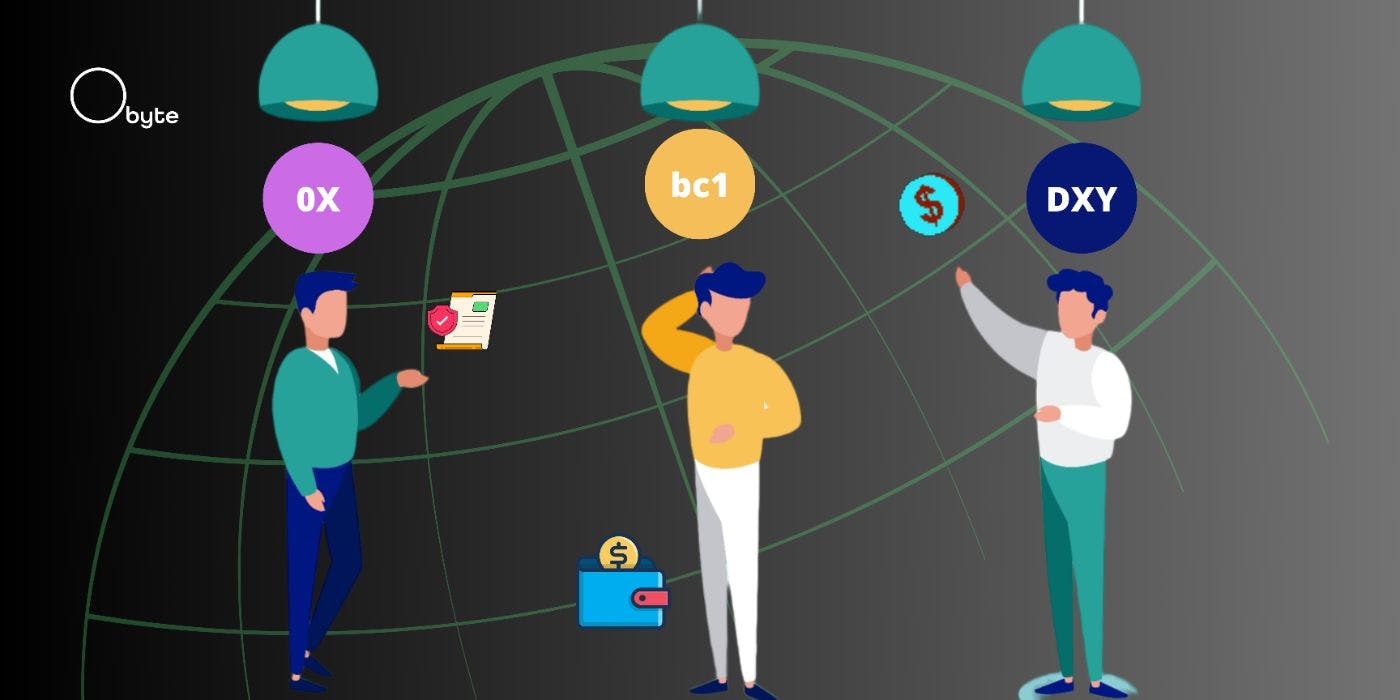Using cryptocurrencies always implies using their addresses. They’re long alphanumeric strings that allow you to send and receive various coins and data securely. Put simply, a crypto address is like a digital mailbox for your digital assets or any other data registered on the ledger. A bank account number for deposits, sort of.
Now, a maybe surprising fact about it: your wallet can issue numerous addresses “containing” different things —not only your traditional transactions. A
To make our point more illustrative, this is the Ethereum address of a smart contract:
0xa6794DEc66Df7d8B69752956df1b28cA93f77CD7
This one here is the Ethereum address of an NFT:
0xc2334d29bdb765a69faa4fa4c102a92a80d24cbdc000933c5fb94afe51f25c46
And this one is an Ethereum address we just created to receive funds in a wallet:
0x60a6fcE47Ed0f6600cAEEa785298Af7CAfDb0a78
They’re not very different, right? All of them start with “0x”, a feature that identifies them as belonging to the Ethereum network (or related ledgers), but nothing else. To know what they contain, you need to visit their
Not exactly public keys
To tell a bit more technical stuff, crypto addresses are a mathematical simplification of a public key. And what is a public key…? You may wonder. Well, in the background, all crypto transactions work thanks to a pair of cryptographic digital keys: a private and a public key. They’re used to sign and verify messages (or transactions), and they’re also alphanumeric strings, but often longer and more complex than shortened crypto addresses.
For instance, this is a public key on Bitcoin:
03f028892bad7ed57d2fb57bf33081d5cfcf6f9ed3d3d7f159c2e2fff579dc341a
And this is a Bitcoin crypto address,
1J7mdg5rbQyUHENYdx39WVWK7fsLpEoXZy
So, crypto addresses aren’t exactly public keys themselves, but a summary of them, easier to use and share. Or so they say, at least. In the case above, the pair doesn’t look very different or much less complex than the other. We still have to copy and paste the thing to avoid mistakes, and that’s very important: cryptocurrencies have their own platforms, and they don’t mix with each other without additional steps (bridges like
This means that you can’t, for instance, send ETH to “1J7” (the Bitcoin address) or BTC to “0x60” (the Ethereum address). You need to use the right type for each ledger, or you’ll lose your assets in the process. That’s why it is advisable to always double-check your crypto addresses before sending funds.
Common Crypto Addresses
How do you avoid mistakes and don’t mix addresses, then? Well, besides double-checking, some exchanges and wallets will warn you that you’re using the wrong type of address. The Obyte wallet, for instance, won’t let you transfer to an invalid address (a non-Obyte type). Now, if you want to identify the network (ledger/coin) from an address alone, here are
-
Bitcoin addresses always start with 1, 3, or bc1. Their length varies between 26 and 35 characters; as an additional sample: bc1prwgcpptoxrpfl5go81wpd5qlsig5yt4g7urb45e.
-
Ethereum addresses always start with 0x and are made up of 40 characters (not including “0x”).
Ethereum-compatible networks like Polygon, BNB Chain, Fantom, and Avalanche also use this format.
-
Litecoin addresses can start with l, m, or 3, and have the same length as Bitcoin addresses. Example: ltc1qzvcgmntglcuv4smv3lzj6k8szcvsrmvk0phrr9wfq8w493r096ssm2fgsw
-
Dogecoin addresses start with D and have a length of 34 characters. Example: D7wbmbjBWG5HPkT6d4gh6SdQPp6z25vcF2
-
Monero addresses start with 4 and 8, and are
even longer : 95 characters. Example: 4AdUndXHHZ6cfufTMvppY6JwXNouMBzSkbLYfpAV5Usx3skxNgYeYTRj5UzqtReoS44qo9mtmXCqY45DJ852K5Jv2684Rge -
Obyte addresses can start with a digit or upper-case letter (all letters are uppercase). They have 32 characters. Example: DXYWHSZ72ZDNDZ7WYZXKWBBH425C6WZN
Get rid of crypto addresses with Obyte!
Do those alphanumeric strings seem to be way too complex for you? We got you! Now, you can receive and send all kinds of transactions without using crypto addresses in Obyte. There are several ways to do it, as a matter of fact. And you’ll only need our friendly wallet and some funds in it, nothing else.
-
Textcoins: you can create secret twelve words containing any amount, and share it digitally (chats, mail, text, etc.) or physically (printed).
The process to do it is quite simple: in the Send tab on the wallet, select “Share Via Message.” On the other hand, if a textcoin was sent to you, you can claim it through the link received or in the Receive tab by selecting “Claim funds using textcoin.”
-
Attestations: you can also attest (verify) your email, GitHub profile, or
a new username to use them instead of an address. The Bot Store in the Chat tab offers severalattestation bots to do this. You just need to select the one you’d prefer (email, GitHub, or username) and follow the instructions. After completion, you can start using any of those items to send and receive funds.
So, are you ready to start trading with and without crypto addresses? We’re waiting for you
Featured Vector Image by Diana Johanna /


